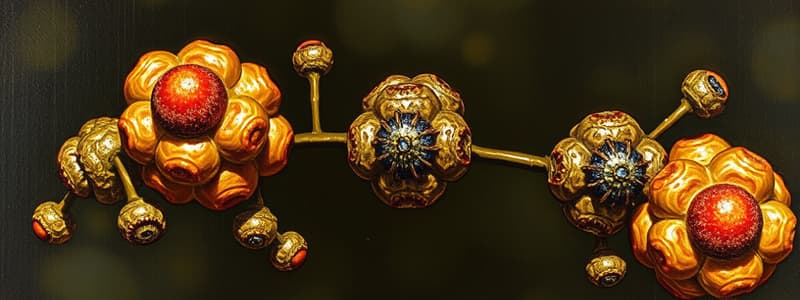Podcast
Questions and Answers
Which type of molecule provides immediate energy?
Which type of molecule provides immediate energy?
- Protein
- Carbohydrate (correct)
- Lipid
- Steroid
What is the monomer of proteins?
What is the monomer of proteins?
- Amino acid (correct)
- Glycerol
- Glucose
- Fatty acid
Which of the following is a carbohydrate that provides long-term energy storage for plants?
Which of the following is a carbohydrate that provides long-term energy storage for plants?
- Starch (correct)
- Glycogen
- Cellulose
- Cholesterol
Which type of lipid is known for its role in forming cell membranes?
Which type of lipid is known for its role in forming cell membranes?
What kind of macromolecule is an enzyme classified as?
What kind of macromolecule is an enzyme classified as?
Which macromolecule is involved in sex hormones?
Which macromolecule is involved in sex hormones?
Which carbohydrate is known for being a structural component in plants?
Which carbohydrate is known for being a structural component in plants?
What is the function of glycerol in lipids?
What is the function of glycerol in lipids?
Which of the following options provides short-term energy storage for animals?
Which of the following options provides short-term energy storage for animals?
Which molecule primarily forms the cell wall of plant cells?
Which molecule primarily forms the cell wall of plant cells?
What type of food molecule would be best to consume for quick energy?
What type of food molecule would be best to consume for quick energy?
Which molecule is considered a polysaccharide found in plants?
Which molecule is considered a polysaccharide found in plants?
Which of the following food molecules would be important for muscle growth?
Which of the following food molecules would be important for muscle growth?
Which food molecule would you likely consume for long-term energy storage?
Which food molecule would you likely consume for long-term energy storage?
Which molecule is found both in animals and plants?
Which molecule is found both in animals and plants?
Which type of molecule would be recommended for someone preparing for a race?
Which type of molecule would be recommended for someone preparing for a race?
Which food type is known for being rich in cellulose?
Which food type is known for being rich in cellulose?
What type of molecule is primarily consumed for repairing body tissues?
What type of molecule is primarily consumed for repairing body tissues?
Which nutrient is primarily responsible for providing energy during hibernation?
Which nutrient is primarily responsible for providing energy during hibernation?
Which statement accurately describes the key structural difference between saturated and unsaturated fats?
Which statement accurately describes the key structural difference between saturated and unsaturated fats?
How do polymers relate to monomers?
How do polymers relate to monomers?
What is the significance of the mnemonic device 'HONC 1-2-3-4'?
What is the significance of the mnemonic device 'HONC 1-2-3-4'?
Which element is considered the most important in organic molecules and why?
Which element is considered the most important in organic molecules and why?
What type of bond does an amino acid form with another amino acid to create proteins?
What type of bond does an amino acid form with another amino acid to create proteins?
If a carbon atom has 4 valence electrons, how many bonds can it form?
If a carbon atom has 4 valence electrons, how many bonds can it form?
Flashcards are hidden until you start studying
Study Notes
Macromolecules Overview
- Macromolecules are categorized into carbohydrates, proteins, and lipids, each serving distinct biological functions.
- Carbohydrates provide energy, structure, and storage; proteins serve as enzymes, structural components, and functional molecules; lipids are vital for energy storage, membrane structure, and signaling.
Classification of Macromolecules
- Carbohydrates: Starch, Glycogen, Glucose, Cellulose, Monosaccharide, Polysaccharide
- Lipids: Cholesterol, Steroids, Saturated fats, Unsaturated fats, Phospholipids, Glycerol
- Proteins: Enzymes, Amino acids, Polypeptides
Functions of Molecules
- Lipids are responsible for long-term energy storage in animals.
- Carbohydrates such as glucose provide immediate energy.
- Proteins are essential for building structures in animals and plants and speeding up biochemical reactions.
- Glycerol serves as a backbone for fats, contributing to lipid structure.
Food Composition
- Foods can be categorized based on their predominant macromolecule:
- Almonds and soybeans are rich in starch.
- Celery and spinach contain cellulose.
- Beef jerky, bacon, egg whites, and lobster are protein sources.
- Sesame oil contains unsaturated fat.
Biological Presence
- Saturated fats and proteins are found in animals.
- Both plants and animals contain proteins, steroids, amino acids, monosaccharides, and polysaccharides.
- Glycogen is exclusive to animals, while cellulose is found only in plants.
- Starch is a plant-based storage form of energy.
Energy Needs and Food Choices
- For a quick energy boost, consume monosaccharides.
- To promote nail growth and muscle development, opt for proteins.
- Long-term energy needs, such as preparing for hibernation or an extended period without food, suggest increased lipid intake.
- For an athletic performance boost, polysaccharides are beneficial.
Short Answer Concepts
- Glucose, fructose, and galactose are isomers, sharing the same chemical formula but differing in structure.
- Saturated fats have no double bonds between carbon atoms, while unsaturated fats contain one or more double bonds, creating kinks in the fatty acid chains.
- Polymers are constructed from monomers through dehydration synthesis, with energy stored in the bonds formed between them.
Elemental Composition in Organic Molecules
- Key elements in living organisms include carbon, hydrogen, oxygen, nitrogen, and phosphorus.
- Carbon's four valence electrons allow it to form diverse bonds, facilitating the structure of various organic molecules.
- The mnemonic "HONC 1-2-3-4" helps remember valence electrons:
- Carbon: 4 bonds
- Hydrogen: 1 bond
- Oxygen: 2 bonds
- Nitrogen: 3 bonds
Studying That Suits You
Use AI to generate personalized quizzes and flashcards to suit your learning preferences.




